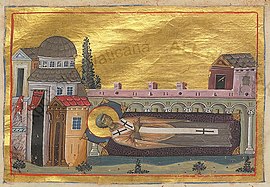Ignatios of Constantinople
Pre-Congregation | |
|---|---|
| Feast | October 23 |
Ignatius of Constantinople | |
|---|---|
| Ecumenical Patriarch of Constantinople | |
| Installed | 847 |
| Term ended | 858, 867–877 |
| Personal details | |
| Denomination | Chalcedonian Christianity |
Ignatius or Ignatios (
Biography

Ignatius, originally named Niketas, was a son of the Emperor Michael I Rangabe and Prokopia. His maternal grandfather was Nikephoros I. Although he was still a child, Niketas had been appointed nominal commander of the new corps of imperial guards, the Hikanatoi. He was forcibly castrated (and thus made ineligible for becoming emperor, since the emperor could not be a eunuch) and tonsured after his father's deposition in 813. He founded three monasteries on the Princes' Islands, a favourite place for exiling tonsured members of the imperial house.
Empress
A fervent critic of the
In 867
Of him the Roman Martyrology recorded the following: "At Constantinople St. Ignatius, Bishop, who, when he had reproved Bardas the Cæsar for having repudiated his wife, was attacked by many injuries and sent into exile; but having been restored by the Roman Pontiff Nicholas, at last he went to his rest in peace."[4] When he died in October 877, Photios was reinstated as patriarch and contributed to Ignatius's canonisation.
See also
- Council of Constantinople (861)
- Council of Constantinople (867)
- Council of Constantinople (869-870)
- Schism of 863
References
- ^ Dvornik 1948.
- ^ Dvornik 1948, pp. 70–90.
- ^ "CATHOLIC ENCYCLOPEDIA: St. Ignatius of Constantinople". www.newadvent.org. Retrieved 2021-10-07.
- ^ "CATHOLIC ENCYCLOPEDIA: St. Ignatius of Constantinople". www.newadvent.org. Retrieved 2021-10-07.
Sources
- Dvornik, Francis (1948). The Photian Schism: History and Legend. Cambridge, UK: Cambridge University Press.
- Ostrogorsky, George (1956). History of the Byzantine State. Oxford: Basil Blackwell.
External links
- The Oxford Dictionary of Byzantium, Oxford University Press, 1991.
 Herbermann, Charles, ed. (1913). "St. Ignatius of Constantinople". Catholic Encyclopedia. New York: Robert Appleton Company.
Herbermann, Charles, ed. (1913). "St. Ignatius of Constantinople". Catholic Encyclopedia. New York: Robert Appleton Company.
